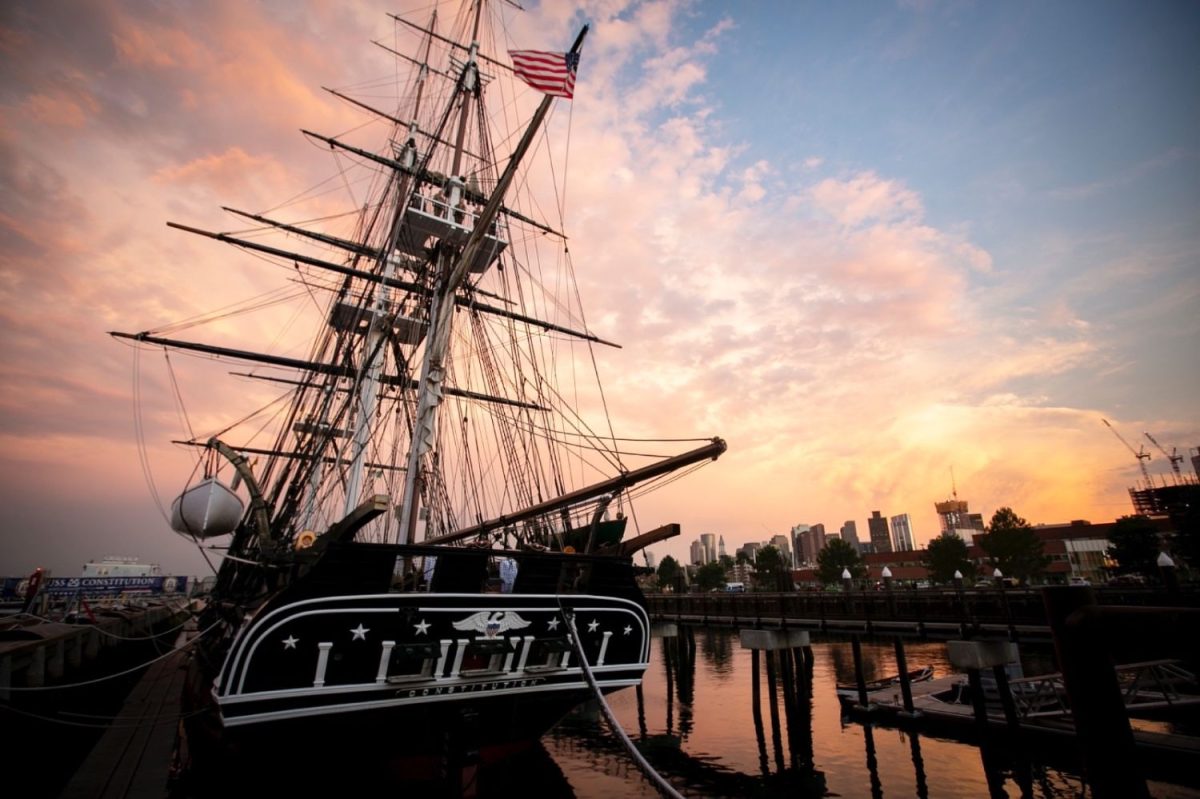The mighty USS Constitution, perhaps the most well-known battleship in American history and a testament to the valor exhibited at sea in the nation’s formative years, celebrated its 227th birthday on October 21.
The vessel prides itself on being the oldest warship in the world today. Instead of being decommissioned, the vessel operates as a floating museum. The ship is usually berthed at one end of Boston’s Freedom Trail, near Pier 1 of the former Charlestown Navy Yard.
Marking its 237th anniversary, the USS Constitution even took sail at the Boston Harbor. According to local reports, around 11:30 a.m. on October 21, the warship fired a 21-gun salute close to Fort Independence.
Later, a 17-gun salute was fired near the U.S. Coast Guard Sector Boston, which is the historic location of Edmund Hartt’s Shipyard, where this ship was originally built. Typically, the big ship sails gently and is accompanied by Coast Guard and police boats as well as helicopters flying overhead.
In honor of the mighty vessel, the U.S. Navy wrote on X (formerly Twitter): “This ship’s undefeated battle record of 33-0 set the tone for America’s Warfighting Navy, and we continue that legacy of warfighting excellence every single day.” The USS Constitution is the only Navy ship still in service to have sunk an enemy warship in combat, a distinction that dates back to the War of 1812 against the British.
Launched in 1797, she was the third of six initial frigates approved for construction by the Naval Act of 1794. She was constructed at Hartt’s shipyard in the present-day North End of Boston, taking three years. Joshua Humphreys designed the frigate, which is nicknamed Old Ironsides after her powerful oak masts and hull.
Despite being classed as a 44-gun frigate, Constitution frequently carried over 50 guns at once. Ships from this era lacked the fixed gun batteries found on modern Navy vessels.
Moreover, since the guns and cannons were designed to be fully portable, they were frequently switched between ships when circumstances demanded. The USS Constitution, for one, remained fully loaded.
Despite the Constitution’s illustrious career, which ended in 1881, Navy officers and crew continue to serve aboard the ship, which is now a floating museum attracting many visitors. The ship has about three officers and nearly 80 enlisted Navy sailors, including both people directly from boot camp and fleet returnees who have served on prior missions.
In addition to offering free tours and keeping her open to guests all year round, the crew participates in ceremonies, educational initiatives, and special events. The assignment is regarded as a special duty, and the officers and crew are all active-duty Navy personnel.
To keep the ship relevant, the crew fires a blank round from the ship’s designated saluting battery two times a day: every morning around 8 a.m. and at sunset.
As part of the Naval History and Heritage Command, the Constitution’s stated objective is to increase public awareness of the Navy’s involvement in war and peace through educational outreach, historical display, and active public events.
USS Constitution Is An American Icon
The first renowned mission, however, came in the early 1800s. Under Captain Edward Preble, she was assigned as the flagship of the Mediterranean fleet in 1803, where she fought the Barbary States of North Africa, who demanded tribute from the United States in return for granting American trade ships access to Mediterranean ports.
Preble launched a fierce offensive against Tripoli, assaulting defenses and closing ports. Ultimately, a peace deal was reached between Algeria, Tunisia, and Tripoli. Following the end of the war, the USS Constitution cruised the coast of North Africa for two years to execute the terms of the treaty.
In 1809, Commodore John Rodgers recommissioned the ship as the flagship of the North Atlantic Squadron. By the beginning of 1812, relations between the United States and Great Britain had hit rock bottom, with the U.S. officially declaring war against its nemesis. The Navy, like other services, started preparing for combat.
Captain Isaac Hull, who had been named Constitution’s commanding officer in 1810, went to sail on July 12 without permission. He intended to join John Rodgers’ fleet, which consisted of five ships.
On July 17, the Constitution saw five ships off the coast of Egg Harbor, New Jersey. By the next morning, the lookouts concluded that they were a British squadron consisting of HMS Aeolus, Africa, Belvidera, Guerriere, and Shannon that had spotted the USS Constitution and was pursuing it.
Since Constitution had become becalmed and could not win the chase, Hull and his experienced crew put boats over the side to haul their ship out of range. Wetting the sails down to take advantage of every wind gust and using kedge anchors to pull the ship forward, Hull gradually gained ground on the British, who were pursuing them.
There were multiple exchanges of cannon fire, but the British attempts—including Belvidera’s attempted broadside—either failed or missed their target. The Constitution outpaced the British on July 19th, forcing them to give up the chase.
Just one month after this engagement, the USS Constitution encountered HMS Guerriere again. The fabled battle began with a shot fired by the British ship.
Twenty minutes later, Guerriere was a dismasted derelict, so badly damaged that the ship was hardly worth dragging to port. Hull had used his ship’s greater sailing capabilities and stronger broadsides. However, on their part, the British were shocked to discover that their shots bounced harmlessly off Constitution’s hull. This earned the USS Constitution its nickname: the “Old Ironsides.”
Later that year, with William Bainbridge in command, Constitution encountered another British frigate, Java. After their three-hour battle, Java was scorched beyond repair. Constitution’s successes greatly boosted the spirits of the American people and elevated the United States to the status of a major naval power.
USS Constitution became renowned for fighting five British warships—the HMS Guerriere, Java, Pictou, Cyane, and Levant—and capturing many commercial ships during the War of 1812 against the United Kingdom.

Despite spending months in port due to blockades or repairs, the Constitution managed eight more captures, including a British frigate and sloop sailing in company before peace was proclaimed in 1815.
Following that, she underwent significant repairs for six years before returning to service as the Mediterranean Squadron’s flagship. The Constitution sailed back to Boston in 1928.
The Boston Advertiser published a ‘news item’ on September 14, 1830, stating that the Navy planned to do away with the Constitution. This stirred a nationwide outrage and gave way to a public campaign advocating to save the vessel from being scrapped. As luck would have it, the ship was not sent to the scrapyard.
The Constitution started a gradual repair process when the Secretary Branch authorized the expenses. She was recommissioned in 1835 when Congress approved funding for reconstruction.
Beginning in March 1844, she embarked on a 30-month journey around the world while serving as flagship in the Mediterranean and South Pacific. She operated as a training ship for midshipmen during the Civil War and cruised the African coast in the 1850s looking for slavers.
Public sentiment prevented her from being scrapped again in 1905; donations from schoolchildren and patriotic organizations allowed her to be restored in 1925.
After being recommissioned in 1931, she undertook a tour of 90 port cities throughout the Atlantic, Gulf, and Pacific coastlines of the United States. Throughout the three-year voyage, she received over 4,600,000 visits. She returned to her home port of Boston after securing her place as an American icon.
She was placed in permanent commission in 1941, and in 1954, an act of Congress gave the Secretary of the Navy responsibility for her maintenance.
237 years after it was commissioned, the USS Constitution, the oldest American warship remaining in service, serves as a potent reminder of the country’s early forays toward maritime domination
- Contact the author at sakshi.tiwari9555 (at) gmail.com
- Follow EurAsian Times on Google News




